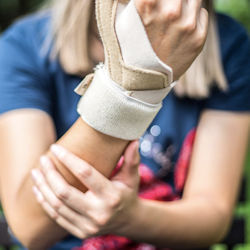Arms, Hands, and Wrists
If you carry heavy objects with hard sharp edges, they can dig into your skin and injure the soft tissues in your hands. Or, if you carry objects that are hard to grip and hold, they may force your hand or wrist into awkward, stressful positions and cause disorders like tendinitis or carpal tunnel syndrome.
Tendinitis
Most of the muscles that move your hand and fingers are actually in your forearm. These muscles are connected to the hand and fingers by tendons, which are like cords passing through your wrist.
You can strain the tendons in your wrist if you frequently exert strong force with your hand, bend your wrist while working, or repeat the same wrist movements over and over. If this strain continues over time, you may develop tendinitis. Tendinitis makes it painful to use your hand, especially to grasp things.
Carpal Tunnel Syndrome
There are 8 small bones in the wrist named carpals. The carpals form a tunnel through which the median nerve and tendons pass through to the hand. If you have tendinitis and your tendons swell, there is less room in the tunnel for the nerve. This causes the median nerve to be pinched causing pain, tingling, or numbness in your hand, wrist, or arm. This condition is called Carpal Tunnel Syndrome.
If left untreated, carpal tunnel syndrome can weaken the hand and make it very difficult to grasp things or even use that hand at all.
Epicondylitis
Forceful twisting motions may cause strain on your elbow tendons, causing discomfort or pain. This condition is called epicondylitis, also known as tennis elbow.
Hand-Arm Vibration Syndrome (HAVS)
This condition is called Raynaud's Syndrome or White-Finger Syndrome. Operating vibrating tools like needle guns, chipping hammers, and rotary hammer drills may lead to finger discoloration, tingling, and numbness. Gangrene is possible in the most severe cases.
For more examples of MSDs, click here.
For more information on general ergonomic factors in the workplace, please see OSHAcademy course 711 Introduction to Ergonomics.
Knowledge Check Choose the best answer for the question.
1-10. Injury to the elbow is called _____.
You forgot to answer the question!

